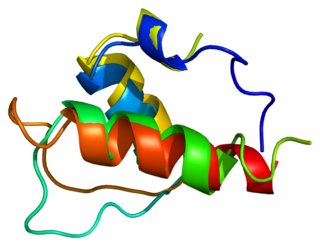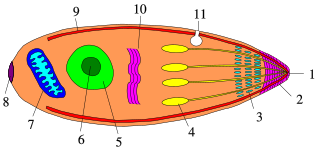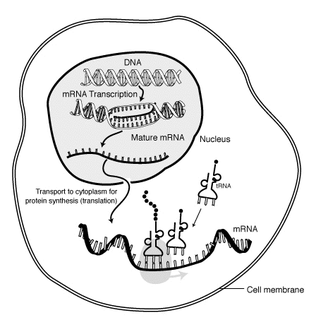
Metabolism is the set of life-sustaining chemical reactions in organisms. The three main purposes of metabolism are: the conversion of food to energy to run cellular processes; the conversion of food/fuel to building blocks for proteins, lipids, nucleic acids, and some carbohydrates; and the elimination of nitrogenous wastes. These enzyme-catalyzed reactions allow organisms to grow and reproduce, maintain their structures, and respond to their environments..

Yellow fever is a viral disease of typically short duration. In most cases, symptoms include fever, chills, loss of appetite, nausea, muscle pains particularly in the back, and headaches. Symptoms typically improve within five days. In about 15% of people, within a day of improving the fever comes back, abdominal pain occurs, and liver damage begins causing yellow skin. If this occurs, the risk of bleeding and kidney problems is also increased.

Mosquitoes are a group of about 3500 species of small insects that are a type of fly. Within that order they constitute the family Culicidae. The word "mosquito" is Spanish for "little fly". Mosquitoes have a slender segmented body, a pair of wings, three pairs of long hair-like legs, feathery antennae, and elongated mouthparts.

Chikungunya is an infection caused by the chikungunya virus (CHIKV). Symptoms include fever and joint pain. These typically occur two to twelve days after exposure. Other symptoms may include headache, muscle pain, joint swelling, and a rash. Symptoms usually improve within a week; however, occasionally the joint pain may last for months. The risk of death is around 1 in 1,000. The very young, old, and those with other health problems are at risk of more severe disease.

Tryptamine is a monoamine alkaloid. It contains an indole ring structure, and is structurally similar to the amino acid tryptophan, from which the name derives. Tryptamine is found in trace amounts in the brains of mammals and is hypothesized to play a role as a neuromodulator or neurotransmitter. Similar to other trace amines, tryptamine binds to human trace amine-associated receptor 1 (TAAR1) as an agonist.

Ferritin is a universal intracellular protein that stores iron and releases it in a controlled fashion. The protein is produced by almost all living organisms, including algae, bacteria, higher plants, and animals. In humans, it acts as a buffer against iron deficiency and iron overload. Ferritin is found in most tissues as a cytosolic protein, but small amounts are secreted into the serum where it functions as an iron carrier. Plasma ferritin is also an indirect marker of the total amount of iron stored in the body, hence serum ferritin is used as a diagnostic test for iron-deficiency anemia.

Cinnamaldehyde is an organic compound with the formula C6H5CH=CHCHO. Occurring naturally as predominantly the trans (E) isomer, it gives cinnamon its flavor and odor. It is a phenylpropanoid that is naturally synthesized by the shikimate pathway. This pale yellow, viscous liquid occurs in the bark of cinnamon trees and other species of the genus Cinnamomum. The essential oil of cinnamon bark is about 55-76% cinnamaldehyde.

A cofactor is a non-protein chemical compound or metallic ion that is required for an enzyme's activity. Cofactors can be considered "helper molecules" that assist in biochemical transformations. The rates at which these happen are characterized by enzyme kinetics.

A transferase is any one of a class of enzymes that enact the transfer of specific functional groups from one molecule to another. They are involved in hundreds of different biochemical pathways throughout biology, and are integral to some of life’s most important processes.

Lamina-associated polypeptide 2 (LAP2), isoforms beta/gamma is a protein that in humans is encoded by the TMPO gene. LAP2 is an inner nuclear membrane (INM) protein.

In entomology, anautogeny is a reproductive strategy in which an adult female insect must eat a particular sort of meal before laying eggs in order for her eggs to mature. This behavior is most common among dipteran insects, such as mosquitoes. Anautogenous animals often serve as vectors for infectious disease in their hosts because of their contact with hosts' blood. The opposite trait is known as autogeny.

Phospholipase A1 encoded by the PLA1A gene is a phospholipase enzyme which removes the 1-acyl. Phospholipase A1 is an enzyme that resides in a class of enzymes called phospholipase that hydrolyze phospholipids into fatty acids. There are 4 classes, which are separated by the type of reaction they catalyze. In particular, phospholipase A1 (PLA1) specifically catalyzes the cleavage at the SN-1 position of phospholipids, forming a fatty acid and a lysophospholipid.

Sphingomyelin phosphodiesterase 1 (SMPD1), also known as acid sphingomyelinase (ASM), is an enzyme that in humans is encoded by the SMPD1 gene.

Aldo-keto reductase family 1 member C3 (AKR1C3), also known as 17β-hydroxysteroid dehydrogenase type 5 is a key steroidogenic enzyme that in humans is encoded by the AKR1C3 gene.

Ribonuclease pancreatic is an enzyme that in humans is encoded by the RNASE1 gene.

Plasma membrane calcium-transporting ATPase 1 is an enzyme that in humans is encoded by the ATP2B1 gene.

60S ribosomal protein L22 is a protein that in humans is encoded by the RPL22 gene on Chromosome 1.

Apicomplexans, a group of intracellular parasites, have life cycle stages evolved to allow them to survive the wide variety of environments they are exposed to during their complex life cycle. Each stage in the life cycle of an apicomplexan organism is typified by a cellular variety with a distinct morphology and biochemistry.
Rickettsia felis is a species of bacterium, the pathogen that causes cat-flea typhus in humans. In cats the disease is known as flea-borne spotted fever. Rickettsia felis also is regarded as the causative organism of many cases of illnesses generally classed as fevers of unknown origin in humans in Africa.

Janet Hemingway is a British entomologist, Professor of Insect Molecular Biology and Director of the Liverpool School of Tropical Medicine (LSTM). She also works on advocacy and resource mobilisation at the Innovative Vector Control Consortium (IVCC), and is International Director of the Joint Centre for Infectious Diseases Research, Jizan, Saudi Arabia. She is "the youngest woman to ever to become a full professor in the UK".





















